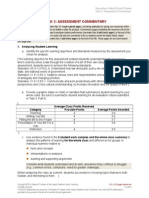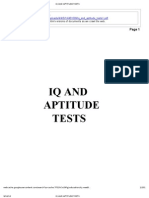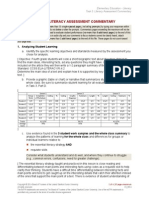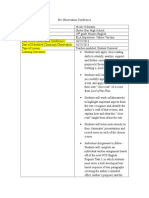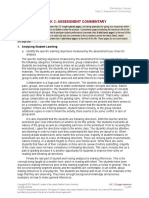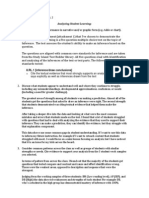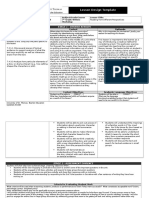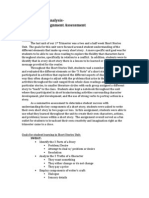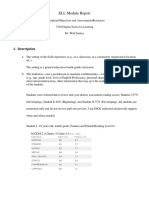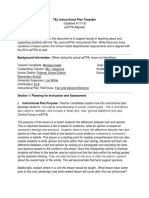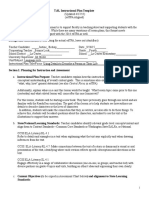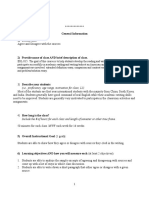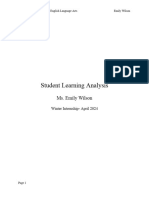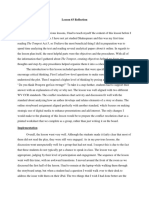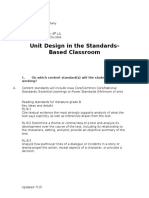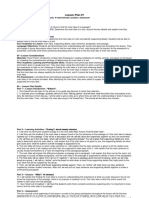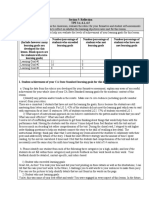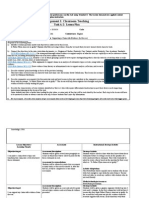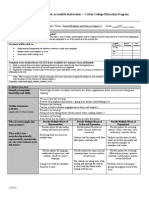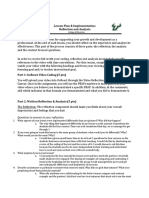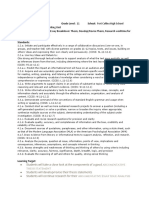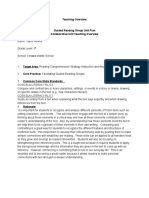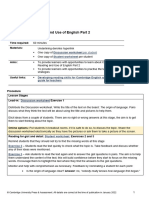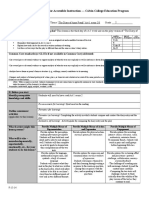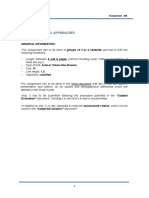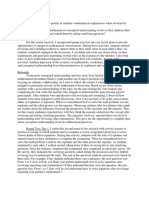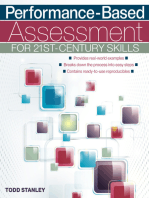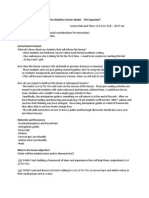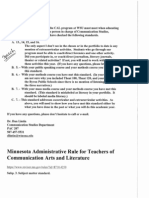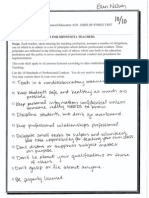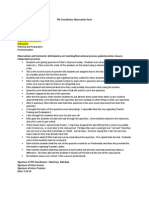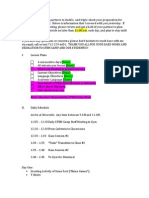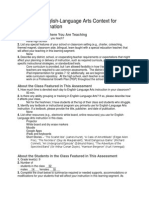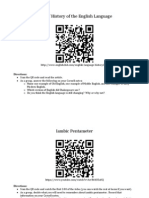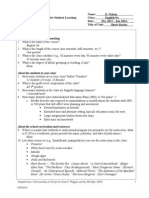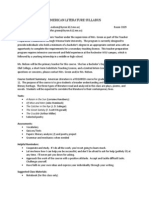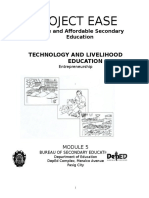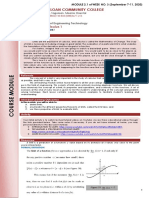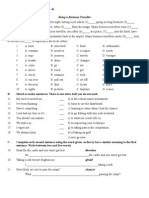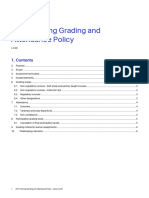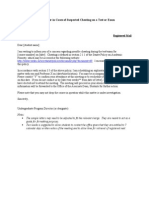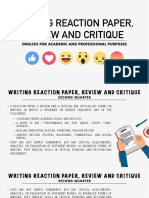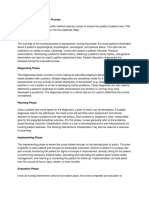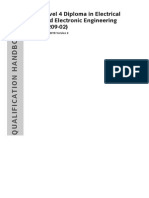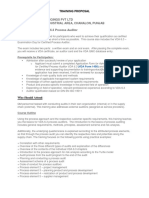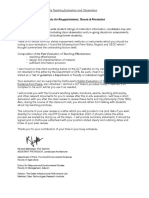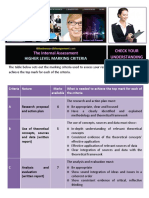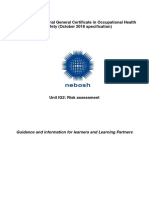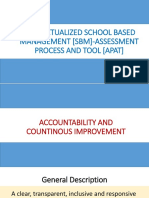3c-Assessment Commentary
3c-Assessment Commentary
Uploaded by
api-250245862Copyright:
Available Formats
3c-Assessment Commentary
3c-Assessment Commentary
Uploaded by
api-250245862Original Title
Copyright
Available Formats
Share this document
Did you find this document useful?
Is this content inappropriate?
Copyright:
Available Formats
3c-Assessment Commentary
3c-Assessment Commentary
Uploaded by
api-250245862Copyright:
Available Formats
Assessment Commentary
Write the Assessment Commentary (no more than 8 single-spaced pages, including prompts) by providing your response to each of the prompts below. 1. Analyzing Student Learning a. Identify the specific standards/objectives from the lesson plans measured by the assessment chosen for analysis. Minnesota State Standards: 9.4.1.1 Cite strong and thorough textual evidence to support analysis of what the text says explicitly as well as inferences drawn from the text. 9.4.2.2 Determine a theme or central idea of a text and analyze in detail its development over the course of the text, including how it emerges and is shaped and refined by specific details; provide an objective summary of the text. 9.4.3.3 Analyze how complex characters (e.g., those with multiple or conflicting motivations) develop over the course of a text, interact with other characters, and advance the plot or develop the theme. Lesson Objectives: SWBAT identify and explore story elements with graphic organizers. SWBAT cite relevant textual evidence to support their claims in discussion and in writing. b. Provide the evaluation criteria you are using to analyze the student learning. The worksheet is worth a total of 5 points. Students work was assessed on the following: 1) completion (at least 4 entries per question) and 2) answers that are based in the text rather than on guesses. If students met both requirements, they scored 5 points; if they met some of the requirements, they scored 3 or 4 points; if students did not complete the worksheet or failed to turn it in, they received 0 points. c. Provide a graphic (table or chart) or narrative summary of student learning for your whole class. Be sure to summarize student learning for all evaluation criteria described above.
Student Learning Summary
5/5 points 4/5 points 3/5 points 2/5 points 1/5 points 0/5 points
d. Use evidence found in the 3 student work samples and the whole class summary to analyze the patterns of learning for the whole class and differences for groups or individual learners relative to comprehending and making meaning from complex text interpreting and/or responding to complex text Consider what students understand and do well, and where they continue to struggle (e.g., common errors, confusions, need for greater challenge). Most of my students were able to answer the first two questions (What does the character do? and What does the character say or think?) on their own, even if they did not go back to the text. They struggled much more with the last two questions (How do others feel about the character? and How does the character change?), which required them to draw some inferences (standard 9.4.1.1). If there were questions left blank, they were consistently the last two questions. In an effort to get students to do their best work from the beginning and help them learn as much as possible about the processes involved in comprehending a complex text, I asked them to first complete as much as they could individually with the text in front of them. Once they had reached the end of their individual abilities, I asked them to share with a classmate and add any new ideas to their own worksheets. When the sharing gave way to gossip and chatting, I brought them together as a large group, and we walked through the four questions together. As we went, I asked them to explain their thinking and to justify their answers with quotes from the text. Again, students were largely able to point to evidence to support their responses for the first two questions, but the last two questions took some time. Those last questions directly address standards 9.4.2.2 and 9.4.3.3, so this worksheet was a great way for me to demonstrate the process of looking for evidence that implicitly supports an answer. My chart shows that the majority of students scored a 5/5, but the worksheet was assessed after our large group discussion; in other words, what students actually ended up being graded on was their willingness to add to their answers during discussion and whether or not they remembered to turn the worksheet in. Even so, I was able to informally assess each students understanding quickly based on how many of our discussion points were on each worksheet. If a student had only a few responses and they were all things we covered in discussion, he or she probably didnt do much individual work; similarly, if a student had additional ideas that were not discussed, he or she likely had a grasp of the depth of characterization. For example, note the responses to question 3 on the student work samples. All three students mention something about bravery (directly stated in the text), pity or sympathy (discussed as a large group), and the fact that the boy was tricked into volunteering to go through the pipe (discussed as a large group). These three students paid attention during the discussion, like most of their classmates. Student 1 has her response about the other diggers treating the boy like family near the top of her list; this was another idea that we discussed as a large group, and I believe it was one that she brought up for discussion. Student 1 is one of my gifted students, and I see it constantly in her work. 2. Feedback to Guide Further Learning Refer to specific evidence of submitted feedback to support your explanations. a. In what form did you submit your evidence of feedback for the 3 focus students? Written directly on work samples or in a separate document;
In audio files; or In video clip(s) from the instruction task (provide a time-stamp reference) or in a separate video clip? Written directly on work samples
b. Explain how feedback provided to the 3 focus students addresses their individual strengths and needs relative to the standards/objectives measured. All three focus students met the requirements and demonstrated progress toward meeting the objectives and standards, so I gave them a 5/5. I did not provide additional written feedback at the time. When 9th graders see a perfect score, they dont look any further; anything else I would have written on their worksheets would have been ignored. However, I took each students individual strengths and needs into consideration when scoring their worksheets. c. How will you support students to apply the feedback to guide improvement, either within the learning segment or at a later time? As I have previously stated, I intend to use this same graphic organizer for one or two more stories in our unit. The next time students encounter the character worksheet, it will be in the context of a new story, and they will have a chance to apply my guidance from our discussion to their own individual work. 3. Evidence of Language Understanding and Use You may provide evidence of language use with your video clips from Task 2 AND/OR through the student work samples analyzed in Task 3. Refer to examples from the clip(s) (with time stamps) and/or student work samples as evidence. a. Explain the extent to which your students were able to use language (selected function, vocabulary, and additional identified demands) to develop content understandings. The language function for this learning segment has to do with analyzing short story elements; during this assessment, students learned what it means to analyze a particular aspect of a text. I like to explain analysis as taking something apart and putting it back together to see the relationship between the parts and the whole. In the case of this character, we picked apart the different ways in which the author characterized him, and then put those pieces back together to get a better picture of the character as a whole. I was very pleased that students followed me to the point of putting it back together; many students would quit after taking everything apart. Our analysis of the character as a whole led us directly into the box at the bottom of the organizer that is labeled 5. Authors theme or point of view. Student 3s work sample proves the depth of students analysis as a whole class. Together, we came up with the theme of family extending beyond biological relations. That theme runs throughout the story, but it is buried beneath the obvious struggle of the boy against his own fear; I was extremely proud of my students for reaching that deeper level of analysis and not settling for the obvious. I told students to write our theme down, but did not specify that it had to be on this graphic organizer. Student 2 probably just chose to write it down elsewhere. 4. Using Assessment to Inform Instruction
a. Based on your analysis of student learning presented in prompts 1cd, describe next steps for instruction for the whole class for the three focus students and other individuals/groups with specific needs Consider the variety of learners in your class who may require different strategies/support (e.g., students with IEPs, English language learners, struggling readers, underperforming students or those with gaps in academic knowledge, and/or gifted students). As a class, my students need more work on standards 9.4.1.1, 9.4.2.2, and 9.4.3.3, which deal with a solid, text-based analysis of complex characters. We will certainly do another character analysis. The three focus students, who are all bright and can be guided to make connections on their own, will likely catch on next time they see this organizer. Other students, like the one on a 504 plan and my one suspected English language learner, will probably need just as much support next time as they did this time. My struggling readers will need as much practice as I can give them. When students have trouble discerning the things that are explicitly stated in a text, navigating the implicit statements can be nearly impossible. For our next story, I would like to give students the same worksheet and see how much they can do on their own after my guidance the first time around. Then I can reassess their understanding of and familiarity with the process and adjust for the next time if necessary. If I wind up with a handful of students who dont even know where to start and another handful who are finished before we even start, I will look for a way to pair those students up and help each other. In that way, my struggling students will receive one-on-one support, and my gifted students will be challenged to explain themselves. b. Explain how these next steps follow from your analysis of student learning. Support your explanation with principles from research and/or theory. (see response to #4a above)
You might also like
- TASK 3 CommentaryDocument4 pagesTASK 3 Commentarybrileinon100% (5)
- Iq and Aptitude TestsDocument201 pagesIq and Aptitude TestsRavi Karthik83% (18)
- EdTPA Task 3Document4 pagesEdTPA Task 3Chelsea Keeney92% (13)
- Performance Appraisal FormDocument1 pagePerformance Appraisal FormGinNo ratings yet
- Portfolio Pre-Observation Close ReadDocument6 pagesPortfolio Pre-Observation Close Readapi-279291777No ratings yet
- Differentiated Lesson PlanDocument4 pagesDifferentiated Lesson Planleahjones73100% (1)
- Mtennantassessment CommentaryDocument7 pagesMtennantassessment Commentaryapi-287349702No ratings yet
- Ppat Section 2Document25 pagesPpat Section 2api-237235020100% (1)
- ASQ CQE Certification Exam Sample QuestionsDocument3 pagesASQ CQE Certification Exam Sample QuestionsDickson ChoyNo ratings yet
- Studies of Independence and Conformity: I - A Minority of One Against A Unanimous MajorityDocument70 pagesStudies of Independence and Conformity: I - A Minority of One Against A Unanimous MajorityJavier Rodríguez LópezNo ratings yet
- Nursing Documentation Final Course Exam IDocument5 pagesNursing Documentation Final Course Exam Iapi-329063194No ratings yet
- Development of Varied Assessment ToolsDocument35 pagesDevelopment of Varied Assessment ToolsCindy Bacsain78% (9)
- Lesson 3Document3 pagesLesson 3api-245823147No ratings yet
- Planning Commentary Part 2Document10 pagesPlanning Commentary Part 2Crystal Atlacamani PerezNo ratings yet
- First Lesson For ObservationDocument5 pagesFirst Lesson For Observationapi-311362989No ratings yet
- Narrative VPPDocument8 pagesNarrative VPPapi-460534464No ratings yet
- Student Work AnalysisDocument7 pagesStudent Work Analysisapi-216700020No ratings yet
- Content Standard(s) Addressed by This Lesson:: STEPP Lesson Plan FormDocument6 pagesContent Standard(s) Addressed by This Lesson:: STEPP Lesson Plan Formapi-282071507No ratings yet
- Elementary Inclusive Preservice Program Lesson Plan: Learning Objective(s)Document5 pagesElementary Inclusive Preservice Program Lesson Plan: Learning Objective(s)api-302044898No ratings yet
- Persuasion TeacherDocument46 pagesPersuasion TeacherBechir Saoudi100% (1)
- Feap 3Document13 pagesFeap 3api-272067310No ratings yet
- Recess Lesson PlanDocument8 pagesRecess Lesson Planapi-425637153No ratings yet
- Glossary of Vocabulary Activities From ModulesDocument4 pagesGlossary of Vocabulary Activities From ModulesEya Guerrero CalvaridoNo ratings yet
- 7430 Ell Report D Roshak Pristupa Final 1Document6 pages7430 Ell Report D Roshak Pristupa Final 1api-659525932No ratings yet
- Petrie - How To Write ThesisDocument8 pagesPetrie - How To Write ThesisFatin Nabihah NilmanNo ratings yet
- T&L Instructional Plan TemplateDocument12 pagesT&L Instructional Plan Templateapi-377446945No ratings yet
- Amandanewcomb BST InductivelessonplanDocument7 pagesAmandanewcomb BST Inductivelessonplanapi-352269670No ratings yet
- Studentteaching Ela Edtpa LessonplanDocument8 pagesStudentteaching Ela Edtpa Lessonplanapi-301667326No ratings yet
- Peng-April 1 Lesson PlanDocument9 pagesPeng-April 1 Lesson Planapi-316796445No ratings yet
- 450 Lesson 2Document7 pages450 Lesson 2api-309613026No ratings yet
- Wilson Emily Sla Winter2024 1Document8 pagesWilson Emily Sla Winter2024 1api-740057041No ratings yet
- 6traits Template Diff MotivationDocument3 pages6traits Template Diff Motivationapi-250000527No ratings yet
- Lesson 3 ReflectionDocument5 pagesLesson 3 Reflectionapi-393127606No ratings yet
- 1 StobDocument4 pages1 Stobapi-257228749No ratings yet
- CEP Lesson Plan Form: CCSS - ELA-Literacy - RL.9-10.3Document11 pagesCEP Lesson Plan Form: CCSS - ELA-Literacy - RL.9-10.3api-309656697No ratings yet
- Lbs 355-01 Paper 1 Draft 3Document4 pagesLbs 355-01 Paper 1 Draft 3api-317936607No ratings yet
- Unit Design in The Standards-Based Classroom: 1. On Which Content Standard(s) Will The Students Be Working?Document10 pagesUnit Design in The Standards-Based Classroom: 1. On Which Content Standard(s) Will The Students Be Working?api-245307519No ratings yet
- Hall Task1 LPDocument13 pagesHall Task1 LPapi-297798957No ratings yet
- Eps513 Final PaperDocument8 pagesEps513 Final Paperapi-255358477No ratings yet
- Lmu Lesson PlanDocument7 pagesLmu Lesson Planapi-260778554No ratings yet
- Lesson 2 450Document7 pagesLesson 2 450api-257595875No ratings yet
- Ast Refelction WebsiteDocument3 pagesAst Refelction Websiteapi-645067057No ratings yet
- Ktip Lesson PlanDocument3 pagesKtip Lesson Planapi-266401226No ratings yet
- Syllabus CBApprovedDocument10 pagesSyllabus CBApprovedVanya AgarwalNo ratings yet
- Teacher Work SampleDocument12 pagesTeacher Work Sampleapi-444858079No ratings yet
- Living Forever Lesson PlanDocument6 pagesLiving Forever Lesson Planapi-425637153No ratings yet
- Lesson 2Document3 pagesLesson 2api-245823147100% (1)
- Causal Arguments Lesson PlanDocument11 pagesCausal Arguments Lesson PlanDarius PowellNo ratings yet
- Lesson Plan & Implementation: Reflection and Analysis: Questions To Answer in Your ReflectionDocument4 pagesLesson Plan & Implementation: Reflection and Analysis: Questions To Answer in Your Reflectionapi-498747980No ratings yet
- Day 5 LPDocument3 pagesDay 5 LPapi-295417045No ratings yet
- Learning To Use A Double Entry JournalDocument14 pagesLearning To Use A Double Entry Journalapi-357529176No ratings yet
- Language Arts Unit PlanDocument35 pagesLanguage Arts Unit Planapi-315492824No ratings yet
- Stage 1 Assignment Audience AnalysisDocument22 pagesStage 1 Assignment Audience Analysisapi-300291867No ratings yet
- c1 Advanced Reading and Use of English Part 2Document11 pagesc1 Advanced Reading and Use of English Part 2Ксения ДейвисNo ratings yet
- Lesson Plan #5: George Washington ResearchDocument7 pagesLesson Plan #5: George Washington Researchapi-252722813No ratings yet
- Midnight's Children LPA #1Document10 pagesMidnight's Children LPA #1midnightschildren403No ratings yet
- Lesson Plan 3 Educ 302Document8 pagesLesson Plan 3 Educ 302api-315445685No ratings yet
- Digital Unit Plan TemplateDocument5 pagesDigital Unit Plan Templateapi-270604493No ratings yet
- FP006 MA Eng - Trabajo Serrano Costa AraujoDocument10 pagesFP006 MA Eng - Trabajo Serrano Costa AraujoAntonella Serrano CostaNo ratings yet
- Round 2 Data Analysis Memo W Round 3 PlanDocument13 pagesRound 2 Data Analysis Memo W Round 3 Planapi-672514046No ratings yet
- Discussion LessonDocument7 pagesDiscussion Lessonapi-264834813No ratings yet
- Teaching For Quality Learning-J.biggsDocument36 pagesTeaching For Quality Learning-J.biggsKevin Dito GrandhikaNo ratings yet
- Lesson 2 - Dont Speak Just To Be HeardDocument3 pagesLesson 2 - Dont Speak Just To Be Heardapi-265442361No ratings yet
- Article WritingDocument10 pagesArticle WritingmutabargaybullayevnaNo ratings yet
- Common Core Snapshot: Administrator's Guide to the Common CoreFrom EverandCommon Core Snapshot: Administrator's Guide to the Common CoreNo ratings yet
- Performance-Based Assessment for 21st-Century SkillsFrom EverandPerformance-Based Assessment for 21st-Century SkillsRating: 4.5 out of 5 stars4.5/5 (14)
- Byron k12 MNDocument1 pageByron k12 MNapi-250245862No ratings yet
- Sample CL 1Document1 pageSample CL 1api-250245862No ratings yet
- Shelley 1a Lesson Plan 11-12-13Document5 pagesShelley 1a Lesson Plan 11-12-13api-250245862No ratings yet
- Content Review FeedbackDocument1 pageContent Review Feedbackapi-250245862No ratings yet
- Ethics TestDocument1 pageEthics Testapi-250245862No ratings yet
- TPC Observation 3Document1 pageTPC Observation 3api-250245862No ratings yet
- Stem Agenda 7 17 13 1Document2 pagesStem Agenda 7 17 13 1api-250245862No ratings yet
- 1a-Context For Learning InformationDocument2 pages1a-Context For Learning Informationapi-250245862No ratings yet
- Language StationsDocument8 pagesLanguage Stationsapi-250245862No ratings yet
- Resume Ellen NelsonDocument2 pagesResume Ellen Nelsonapi-250245862No ratings yet
- Tpa Unit PlanDocument7 pagesTpa Unit Planapi-250245862No ratings yet
- American Literature SyllabusDocument3 pagesAmerican Literature Syllabusapi-250245862100% (1)
- CGBSE Result 2018 PDFDocument6 pagesCGBSE Result 2018 PDFExam ResultsNo ratings yet
- Technology and Livelihood Education Entre Module 5Document22 pagesTechnology and Livelihood Education Entre Module 5Boy Sawaga0% (1)
- Calculus - Module 2.1 of Week 3 PDFDocument4 pagesCalculus - Module 2.1 of Week 3 PDFJimbo J. AntipoloNo ratings yet
- Destination 2 (RT1)Document3 pagesDestination 2 (RT1)oldhastonian100% (1)
- Iata Training Grading PolicyDocument7 pagesIata Training Grading PolicyMikhail KalashnikovNo ratings yet
- Sample Letter in Cases of Suspected Cheating On A Test or ExamDocument2 pagesSample Letter in Cases of Suspected Cheating On A Test or Examhodgeheg9991234No ratings yet
- IC5 L1 T9to16A ScriptDocument1 pageIC5 L1 T9to16A ScriptRichie BallyearsNo ratings yet
- University of Health Sciences LahoreDocument5 pagesUniversity of Health Sciences LahoreAtta Ul MohsinNo ratings yet
- Writing Reaction PaperDocument12 pagesWriting Reaction PaperBurning RoseNo ratings yet
- The 5 Steps of The Nursing ProcessDocument2 pagesThe 5 Steps of The Nursing ProcessManish DafdaNo ratings yet
- Level 4 Diploma in Electrical and Electronic Engineering v2 PDFDocument139 pagesLevel 4 Diploma in Electrical and Electronic Engineering v2 PDFD Gihan PereraNo ratings yet
- Proposal For Training On VDA 6.3process AuditDocument2 pagesProposal For Training On VDA 6.3process AuditAnkurNo ratings yet
- SyllabusDocument4 pagesSyllabusJessicaNo ratings yet
- Tata Trusts - Samarth Presentation - 091117Document29 pagesTata Trusts - Samarth Presentation - 091117varma1234No ratings yet
- Peer Evaluation of Teaching - CONTEXTDocument4 pagesPeer Evaluation of Teaching - CONTEXTRick LeBrasseurNo ratings yet
- Smasud@isrt - Ac.bd: Nstructor Epartment NformationDocument4 pagesSmasud@isrt - Ac.bd: Nstructor Epartment NformationKazi ShahedNo ratings yet
- New FileDocument17 pagesNew FileNirmanyu JamwalNo ratings yet
- Ib Business and Management - Ia Higher Level Marking Criteria PDFDocument2 pagesIb Business and Management - Ia Higher Level Marking Criteria PDFnapa8No ratings yet
- Teacher Coach and Development ProcessDocument8 pagesTeacher Coach and Development ProcessRaymond BartonNo ratings yet
- Brochure Automotive MechatronicsDocument3 pagesBrochure Automotive Mechatronicskottapalli krishna chaitanyaNo ratings yet
- Ig2 Guidance v1 PDFDocument13 pagesIg2 Guidance v1 PDFAbdur Rahman100% (1)
- Edexce Ib CambridgeDocument4 pagesEdexce Ib CambridgeAnonymous 6MSekAxCnZNo ratings yet
- SBM Presentation-Accountability & CIDocument18 pagesSBM Presentation-Accountability & CIRoland Campos100% (3)
